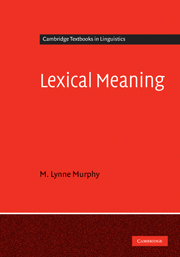Book contents
- Frontmatter
- Contents
- List of figures
- Preface: using this book
- Acknowledgments
- Typographical conventions
- Part I Meaning and the lexicon
- Part II Relations among words and senses
- Part III Word classes and semantic types
- 7 Ontological categories and word classes
- 8 Nouns and countability
- 9 Predication: verbs, events, and states
- 10 Verbs and time
- 11 Adjectives and properties
- References
- Index
8 - Nouns and countability
from Part III - Word classes and semantic types
Published online by Cambridge University Press: 05 June 2012
- Frontmatter
- Contents
- List of figures
- Preface: using this book
- Acknowledgments
- Typographical conventions
- Part I Meaning and the lexicon
- Part II Relations among words and senses
- Part III Word classes and semantic types
- 7 Ontological categories and word classes
- 8 Nouns and countability
- 9 Predication: verbs, events, and states
- 10 Verbs and time
- 11 Adjectives and properties
- References
- Index
Summary
Key words:
count, mass, non-count noun, bounded, internal structure, individual, aggregate, group, substance, linguistic relativity, cultural relativity
Overview
If you tell people that you study lexical semantics or “the meaning of words,” they are likely to assume that you spend your time thinking about things like “What does love mean?” or “What is a table, really?” While some lexical semanticists do think about questions like this, much lexical semantic work on nouns is instead focused on larger categories of nouns with particular morphosyntactic properties and patterns of polysemy. After discussing the types of issues that such nouns raise in the next section, this chapter looks at why it is that some nouns are countable and others are not. That is, some nouns, like cucumber or bungalow, can be preceded by numerals and made plural (104 cucumbers, three bungalows), and others are mass nouns and not usually made plural – for example fog (#three fogs) and wheat (#twenty-seven wheats). After discussing the issue of countability in general, we look at the Conceptual Semantics componential treatment of some countability categories and the polysemy of nouns in relation to those categories, then Chierchia's proposal that mass nouns are inherently plural. Lastly, we look at how languages may differ in their treatment of nouns for particular things and ask whether these differences are arbitrary or culturally predictable, with particular attention to the Natural Semantic Metalanguage approach.
Information
- Type
- Chapter
- Information
- Lexical Meaning , pp. 148 - 171Publisher: Cambridge University PressPrint publication year: 2010
